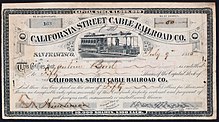California Street Cable Railroad
The California Street Cable Railroad Company operated cable trams in San Francisco . It existed from 1874 to 1951 and was taken over by the San Francisco Municipal Railway , the city's municipal transportation company. Some of the routes are still in operation today.
history
After the success of the first cable car route along Clay Street, entrepreneur Leland Stanford founded the California Street Cable Railroad Company in 1874 . He wanted to build a route from the city center over Nob Hill to the Western Extension district . Construction began on July 5, 1877, and the first section from Sacramento St / Kearny St through Sacramento and California Streets to the intersection of Fillmore Street went into operation on April 10, 1878. The driving time for the 1.7 miles (approx. 2.7 km) was initially 19 minutes. Since then, the line has been officially called "California Street Cable". The depot and drive station of the train was east of Larkin Street, between California and Pine Streets. The route had two cables, each leading from the depot to the two end points. The track width of the tracks was three and a half feet ( Cape gauge , 1067 mm).
On May 30, 1879, an extension from Fillmore Street to Central Avenue (now Presidio Avenue) went into operation, which was initially built on wood planks to save costs. The superstructure proved unsuitable and as early as 1884 it was replaced by normal track systems. Also in 1884, Antoine Borel, a Swiss citizen, acquired the majority of the shares. He drove an expansion project. In 1890 the line was extended at the city end by Sacramento Street to Market Street . A second line called the "O'Farrell-Jones-Hyde Cable" went into operation on February 9, 1891. It ran from O'Farrell Street / Market Street through O'Farrell, Jones, Pine and Hyde Street to Hyde Street / Beach Street. Two cables were also required for this line, each ending at the depot. The two lines crossed at California St / Hyde St. A third line called "Jones Street Shuttle" ran as a shuttle line from Jones Street / Market Street to Jones Street / O'Farrell Street and served to connect the Tenderloin - District. The cable under Jones Street led out of the depot to Jones / Market Street, was diverted there, turned into this at O'Farrell Street, was diverted again at the terminal there and led under O'Farrell and Jones Street back to the depot.
The O'Farrell-Jones-Hyde line crossed ten other cable tram routes on its way. Since it was the last stretch to be built, the cable ran under the cables of the other companies, so that the cars had to disengage at each of these intersections, roll over the intersection with their own momentum, and then click back into place on the other side. At the intersection of California Street, however, the older cable of the train was laid down, so that no notching was necessary here for the new line. However, this was also necessary at the depot and at the Jones / O'Farrell intersection. In total, the car had to be disengaged 22 times during a trip from O'Farrell Street to Hyde Street and back. Due to the closure of many of the crossing routes, however, the number decreased drastically at the beginning of the 20th century.
The greatest incline of the network was on Hyde Street at 20.67%, but California Street also had a gradient of up to 18.2%. Both routes could therefore not be replaced by electric trams, which was the fate of many cable tram routes, especially after the earthquake in San Francisco on April 18, 1906. In this earthquake, the lines and the depot were totally destroyed. Emergency operations were resumed in August 1906, but the repairs, especially at the depot, were not completed until 1908.
The city tried several times to buy the railway company. The concession expired in 1929, but the company did not sell its business and was granted an extension of the concession for another 25 years. The railways remained in operation beyond the Second World War and the company remained independent. In 1949 a passenger was killed when a truck rolled backwards into a tram. The trial ended with the railway company found guilty and having to pay compensation to the relatives. As a result, the insurance company Lloyd's canceled the insurance for the railroad and on July 31, 1951, the California Street Cable Railroad Company ceased operations on their routes because they could not pay for a new insurance. The company was then dissolved. The city bought the railway facility and the San Francisco Municipal Railway , the city's municipal transport company, resumed operations on the three lines on January 13, 1952. On May 15, 1954, it put the O'Farrell-Jones-Hyde line, including the Jones Street Shuttle, out of order and shortened the line on California Street to Van Ness Avenue. In 1957, part of the Hyde Street line reopened as the Powell & Hyde Line. Like the rest of the California Street Line, this is still in operation today and is one of the city's attractions.
literature
- George W. Hilton: The Cable Car in America. (revised version) Stanford CA: Stanford University Press, 1997, pages 193-198. ISBN 0-8047-3052-0
credentials
- ^ Hans Braun: Historical stocks USA. Reflections of the economy. Volume 1, pp. 146f, ISBN 3-87439-397-6

